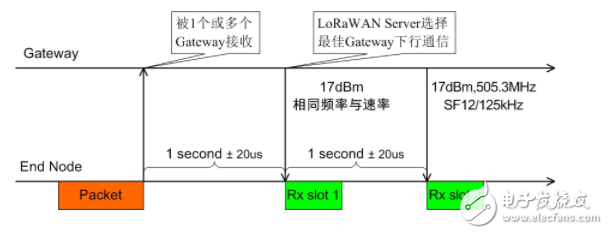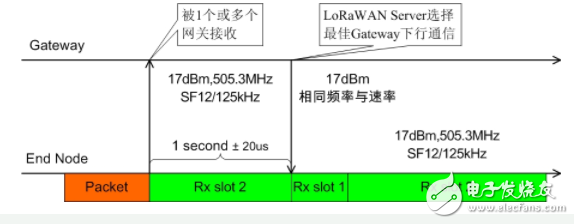This article will introduce the characteristics of sensors, actuators, and actuators. Sensors are the mainstream of LoRaWAN, and actuators are used to calibrate their own clocks. The actuators are designed for actuators with sufficient power.
Different application scenarios require different technical conditions. LoRaWAN divides End Nodes into three categories from the beginning, and they have different battery life and wake-up delays. This is sensible and you can choose the best category based on your application.
1 Characteristics of the three types of terminals
Class A is the mainstream of LoRaWAN, and its communication timing is shown in the figure below. The End Node uploads the data packet according to its own needs, which can be received by one or more Gateways; after 1 second, the most powerful Gateway delivers the data packet at the same frequency and rate as the uplink; if the End Node is in Rx slot1 If the reception is successful, it will no longer open the Rx slot2 window, otherwise it will open the Rx slot2 window according to the 505.3MHz SF12/125kHz (China) condition.
Class A has the best energy savings because it only sleeps when it is sent and 2 receive windows. Of course, the LoRaWAN Server can only communicate downstream after the End Node communicates upstream.

Class B's End Node receives the Beacon broadcasted by the Gateway every 128 seconds to calibrate its own clock. Between the two Beacons, the End Node will open some receiving windows (ping slots). If the Gateway preamble is received during the window period, it will receive the complete afternoon packet.
End Node selects the number of ping slots according to its own power and application needs; to achieve a compromise between energy saving and afternoon communication.

Class C is designed for actuators with sufficient power, such as smart sockets, remote electrical control switches, and more. In addition to sending packets and Rx slot 1, it is received during Rx slot 2, which ensures that the server can communicate downstream at any time.

Our company specializes in the production and sales of all kinds of terminals, copper terminals, nose wire ears, cold pressed terminals, copper joints, but also according to customer requirements for customization and production, our raw materials are produced and sold by ourselves, we have their own raw materials processing plant, high purity T2 copper, quality and quantity, come to me to order it!
Copper Connecting Terminals,Cable Lugs Insulated Cord End Terminals,Pvc Insulated Cord End Terminal,Cable Connector Insulated Cord End Terminal
Taixing Longyi Terminals Co.,Ltd. , https://www.longyicopperterminals.com
